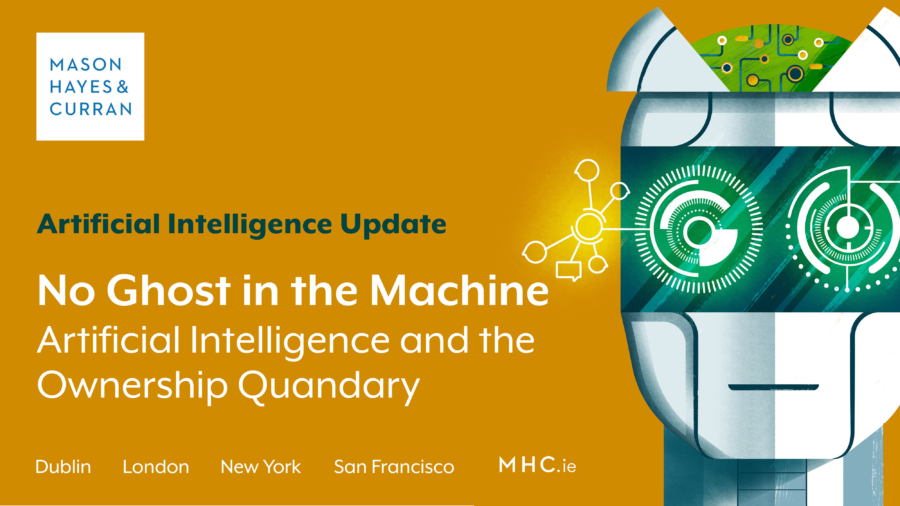
Can a machine be considered the inventor a patent? In the recent decision Commissioner of Patents v Thaler[1], the Australian Full Court held that it was a “legal impossibility” for an AI intelligence system called DABUS to be named as an inventor of a patent, reversing the lower court’s decision to the contrary. Similar DABUS applications are now internationally renowned as having been rejected in several jurisdictions including in the UK, and by the European Patent Office. The general consensus is that an inventor designated in a patent application must be a natural person and cannot be a machine.
In the related UK case of Thaler v Comptroller[2] (Thaler UK), Lady Justice Elisabeth Laing stated “[a] patent is a statutory right and it can only be granted to a person”. In that case, the Court of Appeal held by a two to one majority that the DABUS machine had no right to be an inventor of a patent.
For copyright protected works, the issue of who owns the copyright in an AI or computer-generated work is clearly set out as the person by whom the arrangements necessary for the creation of the work are undertaken. For patents the distinction between a patent owner and an inventor both of which have certain rights under the relevant patent legislation are questions of law. These questions must both be addressed and go beyond a mere consideration of who might own the intellectual property concerned. It is not enough for the patent to belong to the person who owns the relevant machine that invents or who makes the necessary arrangements for the invention to be created, as was the case of Mr Thaler.
We will consider how a similar DABUS application would be treated under Irish law, and the issues that arise with AI ownership.
AI generated or assisted inventions
It is likely that the Irish courts would adopt a similar approach to majority decision in Thaler UK. A strong argument could be made for the Patents Act 1992 (as amended) (the Act), similar to the legislative position in the UK under the Patents Act 1977, implicitly precluding an AI machine from being an ‘inventor’. Section 16 of the Act states that a patent can belong to the inventor or his ‘successor in title’. Regarding this latter phrase, in the UK in Thaler, Lady Justice Laing stated that “[o]nly a person can have a successor in title”. Therefore, a machine cannot be an ‘inventor’ in the legal sense. This would likely be followed in Ireland.
The characterisation of who an inventor can be for a patentable invention is a question of law. Section 17 provides for the applicant for a patent identifying the person or persons whom he believes to be the inventor or inventors within a prescribed period, and should he fail to do so, the application shall be deemed to be withdrawn. Regarding a similar provision in the UK Act in Thaler UK, a distinction was made between, on one hand, the incorrect but bona fide identification of a person as inventor or the failure to identify such a person as inventor, and, on the other, what Mr Thaler was seeking to do – that of positively asserting that there was no such person. Asides from failing to meet the requirements of the provision, the assertion by Mr Thaler that there was no such person was tantamount to saying that the inventor was not a person. As such, he could have no property in the invention under the legislation. Without an identifiable inventor, who must be a natural person, the patent will be refused or deemed withdrawn as happened in the Australian and UK cases above.
Section 9 of the Act provides that patentable inventions must be new and involve an inventive step. In addition, Section 3 states that an invention shall be considered as involving an inventive step if, having regard to the state of the art, it is not obvious to a person skilled in the art. This provides for complexity when considering how these tests are applied to an AI created invention.
The multiple issues arising from these requirements are set out in WIPO’s Draft Issues Paper on Intellectual Property Policy and Artificial Intelligence published in 2019:
- In the context of AI inventions, what art does the standard refer to? Should the art be the field of technology of the product or service that emerges as the invention from the AI application?
- Should the standard of a person skilled in the art be maintained where the invention is autonomously generated by an AI application, or should consideration be given to replacing the person by an algorithm trained with data from a designated field of art?
- What implications will having AI replacing a person skilled in the art have on the determination of the prior art base?
- Should AI-generated content qualify as prior art?
Balancing act
Unsurprisingly, in a consultation undertaken by the UK Intellectual Property Office on AI ownership in respect of copyright, the creative industry took the view that copyright should prioritise human creativity over machine creativity:
The primary argument against protection was a utilitarian one - that machines do not need the same incentives or rewards to create as humans. What might take a human author weeks or months of skill and labour to create, might take a computer program a fraction of a second. But many also cited the inherent value that copyright places on human creativity. For example, the British Copyright Council said that granting copyright protection to machines would devalue the fundamental reason for copyright – “to protect human endeavour and spirit”.
Intellectual property rights exist to reward innovation, while continuing to promote human creativity and innovation. Policy makers should seek to balance these rights in future decisions. As matters stand the legal position is now pretty clear, unless there is a legislative amendment.
For more information, please contact a member of our Intellectual Property team.
The content of this article is provided for information purposes only and does not constitute legal or other advice.
[1] [2022] FCAFC 62
[2] [2021] EWCA Civ 1374
Share this:




